Intel Alder Lake DDR5 Memory Scaling Analysis With G.Skill Trident Z5
by Gavin Bonshor on December 23, 2021 9:00 AM ESTScaled Gaming Performance: High Resolution
Civilization 6
Originally penned by Sid Meier and his team, the Civilization series of turn-based strategy games are a cult classic, and many an excuse for an all-nighter trying to get Gandhi to declare war on you due to an integer underflow. Truth be told I never actually played the first version, but I have played every edition from the second to the sixth, including the fourth as voiced by the late Leonard Nimoy, and it is a game that is easy to pick up, but hard to master.
Benchmarking Civilization has always been somewhat of an oxymoron – for a turn based strategy game, the frame rate is not necessarily the important thing here and even in the right mood, something as low as 5 frames per second can be enough. With Civilization 6 however, Firaxis went hardcore on visual fidelity, trying to pull you into the game. As a result, Civilization can taxing on graphics and CPUs as we crank up the details, especially in DirectX 12.
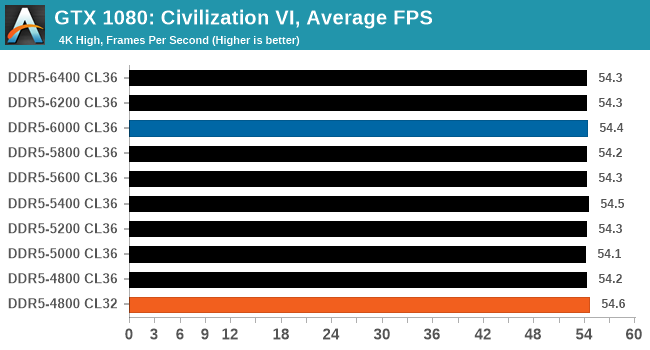

Blue is XMP; Orange is JEDEC at Low CL
Performance in Civ VI shows there is very little benefit to be had by going from DDR5-4800 to DDR5-6400. The results also show that Civ VI actually benefits from lower latencies, with DDR5-4800 at CL32 outperforming all the other frequencies tested at CL36.
Shadow of the Tomb Raider (DX12)
The latest installment of the Tomb Raider franchise does less rising and lurks more in the shadows with Shadow of the Tomb Raider. As expected this action-adventure follows Lara Croft which is the main protagonist of the franchise as she muscles through the Mesoamerican and South American regions looking to stop a Mayan apocalyptic she herself unleashed. Shadow of the Tomb Raider is the direct sequel to the previous Rise of the Tomb Raider and was developed by Eidos Montreal and Crystal Dynamics and was published by Square Enix which hit shelves across multiple platforms in September 2018. This title effectively closes the Lara Croft Origins story and has received critical acclaims upon its release.
The integrated Shadow of the Tomb Raider benchmark is similar to that of the previous game Rise of the Tomb Raider, which we have used in our previous benchmarking suite. The newer Shadow of the Tomb Raider uses DirectX 11 and 12, with this particular title being touted as having one of the best implementations of DirectX 12 of any game released so far.
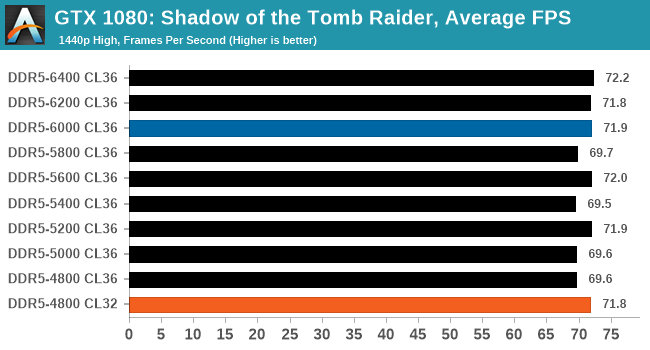
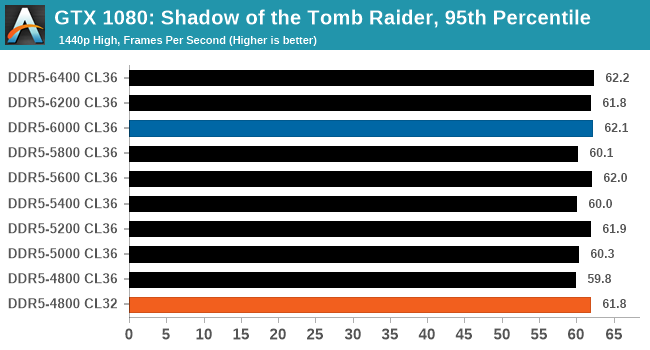
Blue is XMP; Orange is JEDEC at Low CL
Looking at our results in Shadow of the Tomb Raider, we did see some improvements in performance scaling from DDR5-4800 to DDR5-6400. The biggest improvement came when testing DDR4-4800 CL32, which performed similarly to DDR5-6000 CL36.
Strange Brigade (DX12)
Strange Brigade is based in 1903’s Egypt and follows a story which is very similar to that of the Mummy film franchise. This particular third-person shooter is developed by Rebellion Developments which is more widely known for games such as the Sniper Elite and Alien vs Predator series. The game follows the hunt for Seteki the Witch Queen who has arisen once again and the only ‘troop’ who can ultimately stop her. Gameplay is cooperative-centric with a wide variety of different levels and many puzzles which need solving by the British colonial Secret Service agents sent to put an end to her reign of barbaric and brutality.
The game supports both the DirectX 12 and Vulkan APIs and houses its own built-in benchmark which offers various options up for customization including textures, anti-aliasing, reflections, draw distance and even allows users to enable or disable motion blur, ambient occlusion and tessellation among others. AMD has boasted previously that Strange Brigade is part of its Vulkan API implementation offering scalability for AMD multi-graphics card configurations. For our testing, we use the DirectX 12 benchmark.
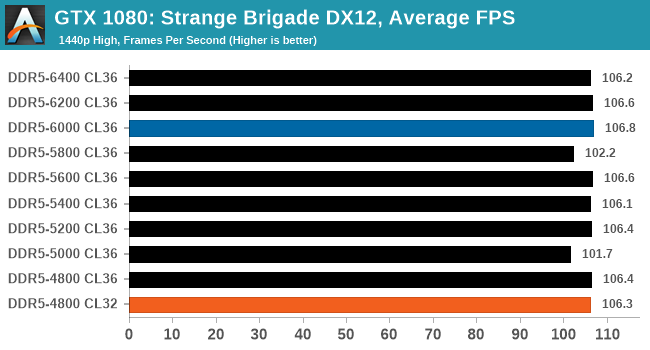
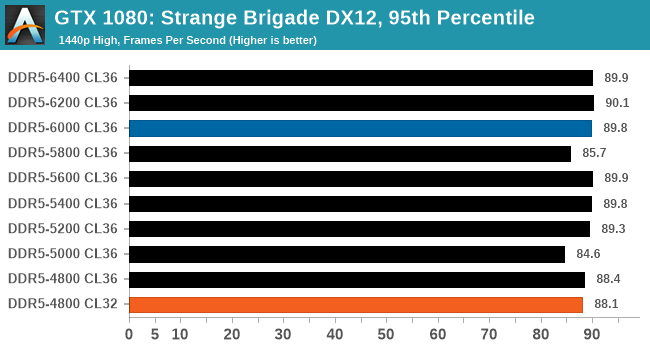
Blue is XMP; Orange is JEDEC at Low CL
Performance in Strange Brigade wasn't influenced by the frequency and latency of the G.Skill Trident Z5 DDR5 memory in terms of average frame rates. We do note however that 95th percentile performance does, for the most part, improve as we increased the memory frequency.


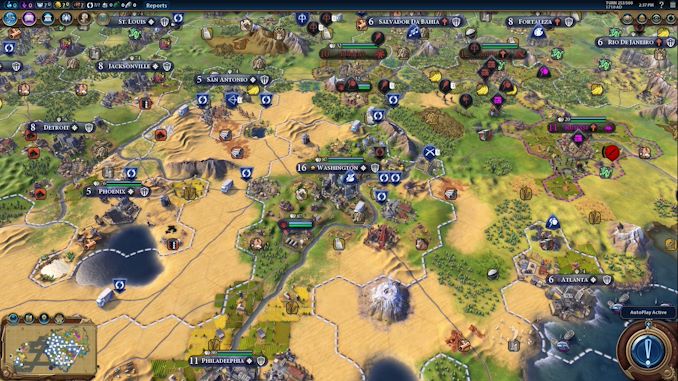
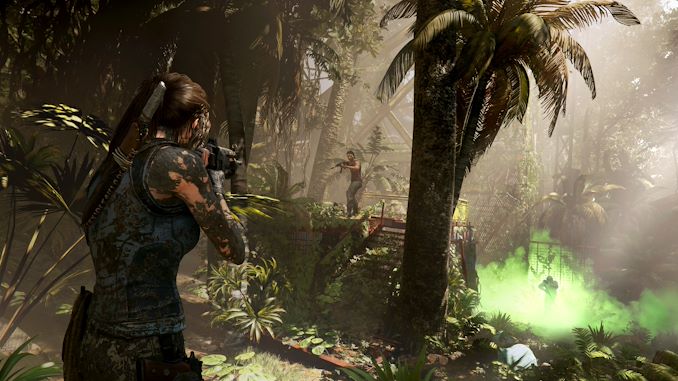









82 Comments
View All Comments
bananaforscale - Wednesday, December 29, 2021 - link
That's DDR4 vs GDDR5, not DDR4 vs DDR5. GDDR is dual ported and can be read from and written to at the same time.29a - Sunday, January 2, 2022 - link
Do you have a source for that for those of us who don't want to take your word? Also this article is about ddr5 memory scaling so I don't know why they half assed the article and didn't do iGPU testing.gagegfg - Thursday, December 23, 2021 - link
I do not understand how in the gaming tests of a top-of-the-range processor and last generation memory combined with a GPU almost 5 years old and 4K and 1440 resolutions, that analysis is really meaningless, they have a terrible bottleneck.HammerStrike - Thursday, December 23, 2021 - link
Yeah, it’s bafflingly. I get the GPU shortage situation is an issue (although you can buy GPU’s, just at inflated prices, not to mention the industry contacts they have), but to test at 1440p / 4k at high settings on a 1080 is just… ignorant?Worse case if you are stuck with the 1080 test at 720p low settings to make the CPU and RAM as much a bottle neck as possible. What they did is just a waste of time.
Ian Cutress - Thursday, December 23, 2021 - link
Ever tried going to a GPU vendor, asking for 2-4+ of the same high-end GPUs (for concurrent testing), during a shortage, saying you can't promise them a review, just for testing? Even with the CPU stuff, it happens once every two generations, maybe, so trying to get one for our motherboard guy is nearly impossible. No we don't have the budget. People complain that I'm running RTX 2080 Ti cards on my CPU reviews. Either we run what we have and the article is written in that context, as mentioned right there on page one no less, or we don't run anything at all.andr_gin - Thursday, December 23, 2021 - link
I understand your problem about not having high end GPUs, but why not at least reduce resolution to 720p?Ryan Smith - Thursday, December 23, 2021 - link
That's an unforced error on our part. We're going to run the numbers for 720p and update the article. Thank you for the feedback.Oxford Guy - Friday, December 24, 2021 - link
More important is DDR-4 data for comparison, particularly at low latencies and nothing below 3200 speed.shabby - Saturday, December 25, 2021 - link
I find it hard to believe you can't source a video card, no other reviewers have this issue and I bought two myself this year.Ooga Booga - Tuesday, December 28, 2021 - link
1) Go to Oxford for transistor studies2) See moron youtubers become millionaires running canned benchmarks
3) Still refuse to leave Anandtech